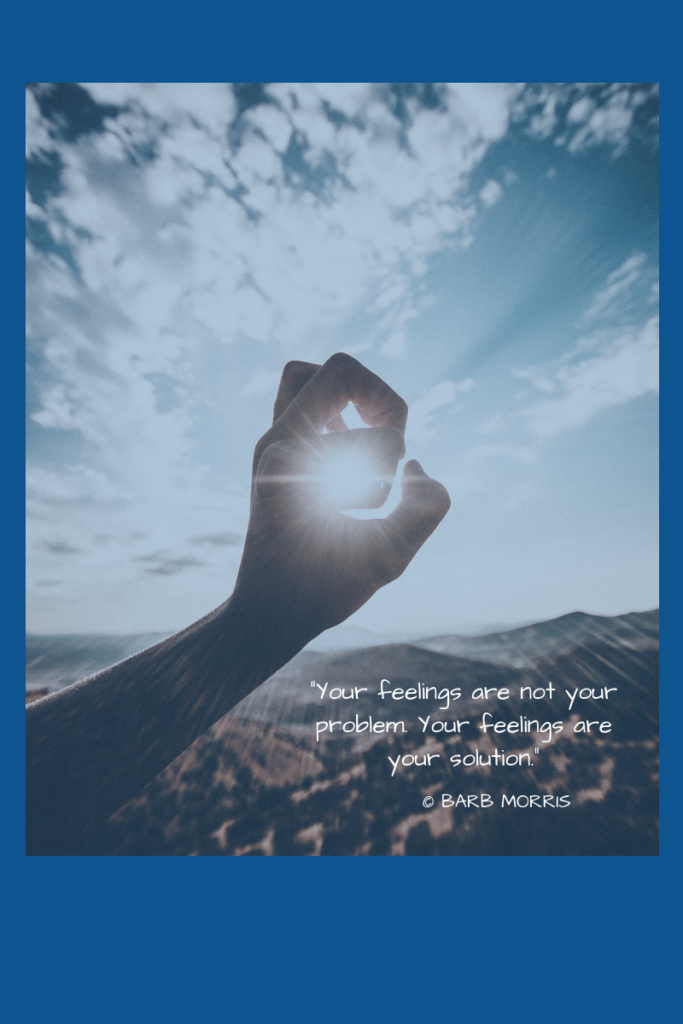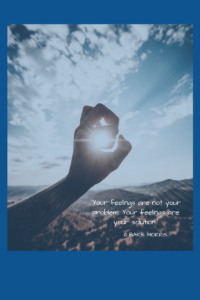
The source of your woundedness isn’t what you think it is. The reason you feel broken isn’t what other people did to you. You don’t feel broken because of the things that have happened to you. The source of your wounds is your beliefs. You feel broken because of your thoughts about those people and those events.
This is good news.
You can’t change other people, and you can’t change the past. What you are totally and completely in charge of is your thoughts and beliefs. The source of our sickness is who we believe ourselves to be – our foundational metaphors. If we’re swimming in a polluted worldview, our lives will be sick. (Last week’s very long post goes into this concept in detail.)
We heal when we learn to think healing thoughts. It’s that simple.
Two things I’m not saying: I’m not saying that others’ bad behavior is okay. I’m not saying you should overlook someone else’s violence or tolerate boundary violations, and just think happy thoughts. I’m not telling you to forgive, although that may happen.
I’m also not promoting the Law of Attraction – the belief that my thoughts make things happen in the physical world. This is different. The work I’m talking about changes who I think I am, which then affects the world around me. There’s a big difference between the magical thinking of manifesting 101 and the hard work of learning to think healing thoughts.
I am talking about solid neuroscience. We see what we tell our brains to look for. If your worldview is negative, you’ll find ample evidence to prove your beliefs, and you won’t change your mind. Your polluted metaphor has shaped your brain in profound ways. Your current worldview is like an eight-lane neuron superhighway that’s easy and automatic. And so very unhelpful. Our brains want to stay on this wide, fast, easy street precisely because it’s easy and automatic. Back in cave woman days, when resources were scarce, our brains evolved to favor the easy and automatic. Learning new ways of thinking and building new neuron pathways requires energy, so our brains, still stuck in survival mode, resist it.
Most of us aren’t currently living in food scarcity, in fear of saber-toothed tiger attacks. We can afford the resources to rewire our brains, if we choose to. But, because learning to think healing thoughts is uncomfortable and often not supported by your family and friends, you must make it your priority. Your health and wholeness must be your priority. If it’s not, you won’t do it. Why not? Because rewiring your brain is freaking hard, scary work.
Why does healing feel so scary? Why do we resist it?
1.This wounded place is familiar. When we accept the healing that’s always offered, we choose to travel an unfamiliar road into unknown territory – the opposite of easy and automatic. Our brains resist this.
2. When we regrow and expand parts of ourselves on our journey toward wholeness, it can hurt, just like when blood flows into your leg that’s been asleep, or into a frostbitten hand. You get a functioning limb at the end of the process, but the process can hurt like hell.
3. We’ve constructed our lives based on being one particular shape. When we let our shapes flow and grow, the lives we’ve built will inevitably be disrupted. Healing leads to change, and change always destroys one thing while something new is created. Metamorphosis is naturally destructive.
When we regrow and expand a part of ourselves, our new shape can cause friction. We rub against others differently. They might not want to stay connected to us. We might not want to stay connected to them!
4. These newly grown or uncovered parts, like babies and puppies, will be messy and disorganized, at least for a time. They are raw and vulnerable and sensitive. So healing can cause feelings of incompetence and lostness, which are especially disruptive for those of us who put a premium on feeling competent and confident.
Our armor has been our protection. Our armor has also been constraining, a too-small skin. Armor has kept us safe, but it’s also been heavy, clanky, and inflexible. When we uncover, shed layers, grow new limbs, we can feel raw, exposed, and ungainly.
So why choose to heal, if healing is uncomfortable, painful, and disruptive?
We are created by God, the Ultimate Wholeness, in whom we live and move and have our being, to be whole, holy, and healthy. The Holy One wants us to heal.
A healed life is a powerful life. When we stop spending our time and energy staying small and playing nice, we can use our time and energy to change the world. We can stop scoping for danger and worrying about being acceptable, and start seeing the broken places around us where we can bring healing. We can use our anger for good, rather than stuffing it because we’re afraid someone (looking at you, patriarchy) won’t like us.
Because we’re adults now, and we can keep ourselves safe. Because we have an inkling we’re not living the life we were put on this earth to live. Because we know there’s more joy and love on the other side of healing. Because once we see the ways we’re choosing safety and smallness, we can’t unsee them. Because choosing to stay armored and small requires more energy than finally shrugging off the armor to run light and free.
Because living as people who trust ourselves and our good hearts, people listening to our souls, is our calling.
The choice to heal, to learn how to feel fear and act in spite of the fear, makes us invincible. Unstoppable. And legions of invincible, unstoppable warriors leading healed lives will change and heal our world.
Two of my favorite “thought work” resources are Kara Lowentheil’s blog and podcast, Unf*ck Your Brain (heads up: Kara uses salty language) and The Work of Byron Katie. These two resources are very different in tone but their aim is the same: choosing thoughts deliberately.
As always, if you’d like to talk more about these ideas and get some immediate clarity, please schedule a no-cost, no-obligation call with me here.
Image: The Bear and the Child, kid-lit.net, photographer unknown


